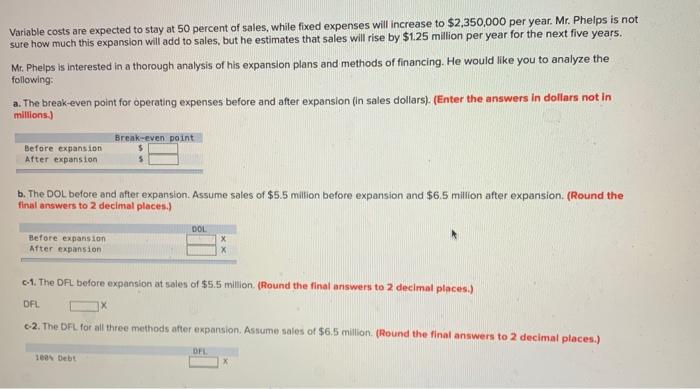Phelps Canning Company is considering an expansion of its facilities. Its current income statement is as follows: Sales Less: Variable expense (50% of sales) $5,500,000 2,750,000 1,850,000 Fixed expense Earnings before interest and taxes (EBIT) Interest (180 cost) 900,000 300,000 Earnings before taxes (EBT) Tax (401) 600,000 240,000 Earnings after taxes (EAT) $360,000 Shares of common stock EPS 250,000 51.44 Phelps Canning Company is currently financed with 50 percent debt and 50 percent equity (common stock). To expand facilities, Mr. Phelps estimates a need for $2.5 million in additional financing. His investment dealer has laid out three plans for him to consider 1 Sell $2.5 million of debt at 13 percent 2. Sell $2.5 million of common stock at $20 per share. 3. Sell 51.25 million of debt at 12 percent and $125 million of common stock at $25 per share. Variable costs are expected to stay at 50 percent of sales, while fixed expenses will increase to $2,350,000 per year. Mr. Phelps is not sure how much this expansion will add to sales, but he estimates that sales will rise by $1.25 million per year for the next five years. Variable costs are expected to stay at 50 percent of sales, while fixed expenses will increase to $2,350,000 per year. Mr. Phelps is not sure how much this expansion will add to sales, but he estimates that sales will rise by $1.25 million per year for the next five years. Mr. Phelps is interested in a thorough analysis of his expansion plans and methods of financing. He would like you to analyze the following: a. The break-even point for operating expenses before and after expansion (in sales dollars). (Enter the answers in dollars not in millions.) Break-even point Before expansion After expansion b. The DOL before and after expansion. Assume sales of $5.5 million before expansion and $6.5 million after expansion (Round the final answers to 2 decimal places.) DOL Before expansion After expansion c-1. The DA before expansion at sales of $5.5 million (Round the final answers to 2 decimal places.) DFL 2. The DFL for all three methods after expansion Assume sales of $6.5 million (Round the final answers to 2 decimal places.) DFL. 100 Debt D. IN VUL Detore and after expansion. Assume sales of >5.5 mmion Derore expansion and >6.5 milion arter expansion. (nouna une final answers to 2 decimal places.) DOL Before expansion After expansion c-1. The DFL before expansion at sales of $5.5 million (Round the final answers to 2 decimal places.) DFL c-2. The DFL for all three methods after expansion Assume sales of $6.5 million. (Round the final answers to 2 decimal places.) DFL 100 Debt 100Equity 505 Debt & 509 Equity d. Compute EPS under all three methods of financing the expansion at $6.5 million in sales (first year, and $10.5 million in sales (last year). (Round the final answers to 2 decimal places.) EPS First year Last year 100 Debt 5 1005 Equity 509 Debt 5 5e Equity e. Not available in Connect









